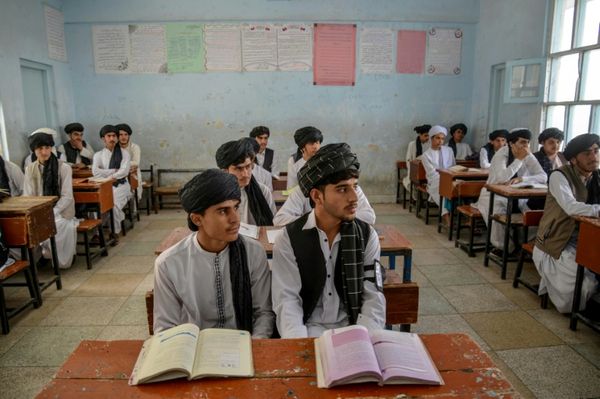On Friday morning, meteorologists mapping the trajectory of Tropical Cyclone Alfred were predicting it would make landfall either Friday night or Saturday morning somewhere between Noosa and Coolangatta. The most recent tracking map suggested it could cross north of Brisbane.
Alfred’s slow progress to the mainland could prolong already severe conditions to the south of its projected path, particularly in parts of the Gold Coast and northern New South Wales.
Thousands of people in parts of the NSW Northern Rivers were told to leave their homes on Thursday night, including residents in Lismore’s CBD, north and south. Evacuation orders were issued as far south as the Nambucca shire, more than 400km south of the Queensland-NSW border.
The NSW State Emergency Service warned people in 11 locations to evacuate before 9pm on Thursday: Uki, Fingal Heads and Tumbulgum in the Tweed catchment; North Lismore, South Lismore, Lismore CBD and East Lismore in the Lismore catchment; Bungawalbin and low-lying parts of Kyogle and Coraki in the Richmond catchment; and Billinudgel in the Brunswick catchment.
Queensland police warned people on the Gold Coast to prepare to take shelter on Thursday night.
Authorities in Brisbane said 20,000 properties in the city were at risk of inundation from a storm surge or flooding as Alfred continued its track towards the populated south-east Queensland coast.
When and where is Tropical Cyclone Alfred going to hit?
The bureau’s track maps include a large area in grey outside the main track that represents the area where the cyclone could go.
In advice published at 7.52am Queensland time (8.52 AEDT) on Friday, the BoM said the centre of Alfred was expected to cross the Queensland coast at about 10am on Saturday morning, most likely between Double Island Point and Noosa and just south of Brisbane’s CBD. Staying up to date with the maps is the best way to stay informed.
At 9am Queensland time (10am AEDT) on Friday, the BoM said Alfred remained a category 2 system with sustained winds near the centre of 100km/h with wind gusts to 140km/h. It was still moving slowly towards the coast, 160km east of Brisbane and 135km east-north-east of the Gold Coast.
The centre of the cyclone was expected to cross over the Moreton Bay Islands on Saturday morning before crossing the mainland coast, most likely between Noosa and Beenleigh, later during Saturday.
Communities from Double Island Point in Queensland to Grafton in NSW – including Brisbane, Gold Coast, Sunshine Coast, Byron Bay and Ballina but not including Grafton – were in the warning zone as of Friday morning.
Since Thursday night, the strongest wind gusts have been seen at Cape Byron, where there was a mean wind speed of 92km/h and gusting up to 120km/h. Gold Coast airport also experienced 100km/h wind gusts, with Evans Head and Cape Morton seeing 98km/h wind gusts.
Destructive wind gusts of up to 155km/h may develop about the Moreton Bay Islands and exposed coastal locations on the northern Gold Coast from Friday night, the BoM said, as Alfred’s destructive core approaches the coast.
Cyclones rotate clockwise, meaning the strongest onshore winds are underneath the eye.
Potentially life-threatening floods
As well as high winds and storm surges, affected areas were preparing for intense rainfall that the bureau warned could lead to life-threatening flash flooding.
“Unfortunately, the northern river systems and New South Wales are already on their way to major flooding,” said Sarah Scully, a senior meteorologist at the BoM.
The Bellinger River in NSW was already at moderate flood level on Friday morning. Major flood warnings have also been issued for the Logan, Tweed, Brunswick, Wilson, Richmond, Orara, Bellinger and Nambucca rivers of NSW, with more flood warnings and watches likely to be upgraded over the coming days.
In the 48 hours to 6am Friday AEDT, parts of NSW had already seen hundreds of millimetres of rain, with 440mm falling at Meldrum, 429mm at Dorrigo and 321mm at Mullumbimbi. The rain has been slightly lighter in Queensland: 246mm at Lower Springbrook, 206mm at Currumbin Creek and 170mm at Coolangatta.
Scully said Brisbane had experienced far lighter rainfall totals and was yet to see any of the gale-force winds because it was far more sheltered from the south and further away from the coast.
“We are expecting Brisbane winds to start to build throughout today and into this afternoon, and also the rainfall to increase as well,” she said.
Abnormally high tides are also expected to continue to cause flooding to low-lying areas between Double Island Point and Ballina, particularly during the high tide early on Saturday night. Damaging surf and significant beach erosion is likely for the open beaches between Double Island Point and Grafton, and further south over the NSW coast.
Which suburbs are at risk?
Earlier in the week the Brisbane lord mayor, Adrian Schrinner, said the suburbs “most at risk” were beachside communities – including Nudgee Beach and Brighton – and low-lying suburbs near rivers and creeks, including Windsor, Ashgrove, Morningside and Rocklea.
South of the city, Redland city council has issued warnings for a “very dangerous storm tide” for coastal areas.
Gold Coast city council is warning of destructive wind gusts and significant flooding.
Evacuation centres
Brisbane city council has set up a temporary refuge shelter at RNA showgrounds, and two further shelters would be set up on Friday “if required” at the Chandler arena in Chandler and Kedron Wavell in Chermside. More information can be found on the council’s website.
Gold Coast city council has opened evacuation centres at Runaway Bay indoor sports centre, Burleigh Waters community centre and Pimpama sports hub.
Moreton Bay had three evacuation centres open by Friday morning, at Caboolture memorial hall, Strathpine community centre and the Hope Centre in Rothwell.
In NSW multiple evacuation centres have been set up all the way down the coast from the Queensland border as far south as Port Macquarie. A full list of centres with their opening times is on the NSW SES website.
Why is this a big deal?
Tropical cyclones are typically a tropical phenomenon and the fact that Alfred could reach the coastline hundreds of kilometres south of the tropics could be quite dangerous.
There is a huge population in the potential path of the cyclone of more than 4 million people, most of them living in and around Brisbane. And the Queensland capital is not particularly well-equipped to cope with a cyclone.
Residents of north Queensland and the Northern Territory are well-versed in preparing for cyclones; most have a cyclone kit with emergency supplies, and many buildings and homes are constructed to withstand strong winds.
Brisbane is also used to storms but doesn’t cope particularly well with them. The city has severely flooded three times (in 2011, 2017 and 2022) in the past 15 years. Predictions of 300mm to 600mm of rainfall in some areas, after a particularly wet summer, are worrying authorities.
It is unusual to be taking the threat of a cyclone this seriously this far from it making landfall. But authorities are taking this very seriously.
When was the last cyclone in Brisbane?
It is rare – but not unheard of – for tropical cyclones to reach landfall south of the tropics.
The closest a cyclone track has come to Brisbane was in 1990 when Tropical Cyclone Nancy tracked erratically towards the Queensland capital before taking a southward turn just off the coastline and never making landfall.
Tropical Cyclone Wanda – the cause of Brisbane’s historic 1974 floods – crossed the coast near K’gari and Hervey Bay. A severe tropical cyclone crossed the coast near Tweed Heads in 1954.
It is far more common for a tropical cyclone to cross the coast north of the Tropic of Capricorn and return overland to the south-east as a destructive low storm. This occurred with Cyclone Debbie in 2017.
How should people prepare?
The Queensland government has a guide for residents to get ready for cyclones, which includes packing a kit with enough basic items for your family to use for three days at home without power.
Residents should make sure loose items are secured or put away.
How will travel and public transport be affected?
On Friday morning, Qantas announced an extension of its suspension of all flights – including budget carrier Jetstar – out of Brisbane, Gold Coast and Ballina airports until at least Sunday morning. Virgin operations are also suspended in those airports until at least Sunday morning.
All bus, train, ferry and tram services in south-east Queensland have been suspended until further notice. Updates will be provided on the Department of Transport and Main Roads website.
The department also said it expected damage to roads and bridges due to flooding as well as high winds.
The Brisbane regional harbour master has issued a red alert for those on boats to seek/take shelter, and no vessels are permitted on the water until further notice.
NSW and Queensland school closures
Hundreds of schools across south-east Queensland and northern NSW will be closed on Friday, with 1,051 schools closed in Queensland including 663 state schools, and 254 NSW public schools, along with some independent schools.
Tafes and universities – including the University of the Sunshine Coast, Queensland University of Technology, the University of Queensland and Griffith – have closed their campuses.
Theme parks closure extended
Village Roadshow said the closure of Gold Coast theme parks, including Movie World, Sea World and Wet’n’Wild, would be extended to Sunday, but it would “provide updates as the situation progresses”.
Read more of Guardian Australia’s Tropical Cyclone Alfred coverage:







